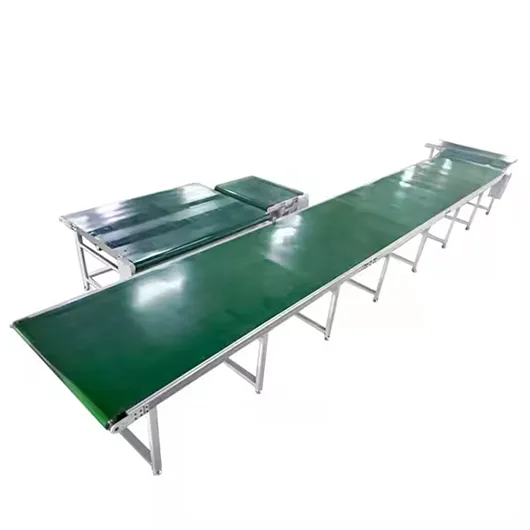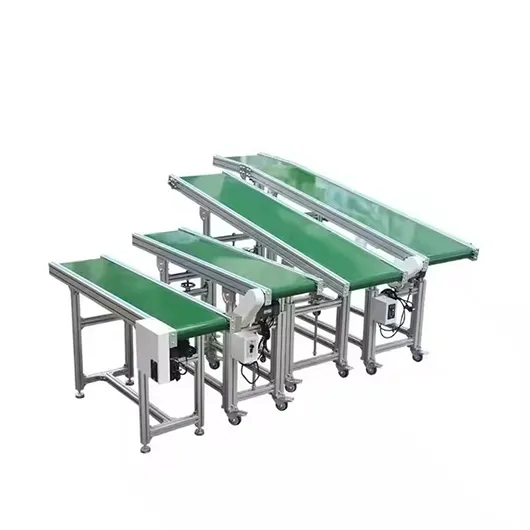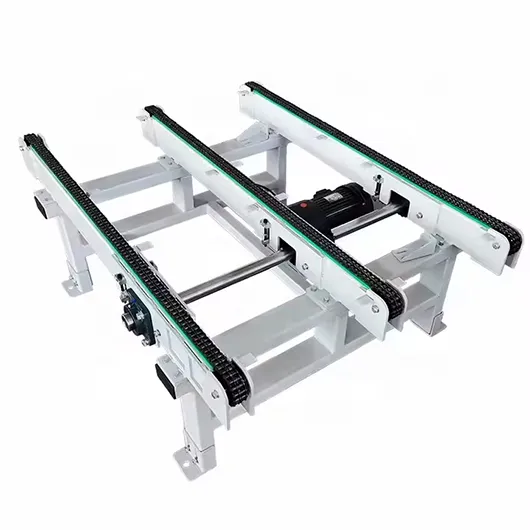Avoid your inquiry is delay response, please enter your WhatsApp/Skype along with the message, so we can contact you at the very first time.
We will reply you within 24 hours. If for urgent case, please add WhatsApp/WeChat: ,. Or call directly.
Many factories rely on conveyor systems, but choosing between a belt and a chain conveyor often causes confusion. I’ve seen both in action, and knowing the difference helps pick the right tool for your production line.
The key difference between belt and chain conveyors is in their structure and application: belt conveyors use a continuous flat belt to move items, while chain conveyors use interlinked chains designed to handle heavier loads.

Understanding how these two systems work helps improve efficiency, reduce downtime, and match your equipment to your production needs. Let’s explore where chain conveyors are used, compare efficiency, discuss chain drive advantages, and consider if belts can replace chains.
Chain conveyors are often overlooked unless heavy loads or challenging conditions are involved. I’ve found them especially valuable in rugged environments where reliability matters more than speed.
Chain conveyors are typically used in manufacturing, automotive, and heavy-duty assembly lines1 where items are bulky, hot, sharp-edged, or too heavy for belts.
Chain conveyors play a major role in sectors that demand strength, durability, and precise movement. These machines can carry items that belts cannot—either due to size, weight, or environmental challenges.
In automotive plants, chain conveyors are used to transport vehicle frames, axles, and engine parts. These components are too heavy for most belt systems, and the chains allow fixtures to be attached for precise movement and assembly.
Chain conveyors are ideal in settings where belts would melt or degrade. Foundries, heat treatment lines, and furnaces use chain conveyors because chains can handle extreme heat, debris, oil, and chemicals.
Palletized goods are often transported using chain-driven systems. The chain links can interface directly with wood or metal skids, eliminating the need for smooth surfaces. They are commonly used in palletizers, depalletizers, and end-of-line packaging zones.
When products need to stop, index, or follow a precise path, chains provide control. Fixtures can be mounted on the chain to hold items in place, making chain conveyors ideal for robotic assembly and welding lines.
| Chain Conveyor Use Case | Why Chain is Preferred |
|---|---|
| Car assembly lines | Heavy-duty transport with high accuracy |
| Pallet transfer stations | Supports rugged skids with consistent spacing |
| Paint shops | Resistant to solvents and heat |
| Foundries and kilns | Withstands high temperatures and debris |
| Automated welding lines | Offers fixture mounting for precise handling |
Chain conveyors are built for strength and longevity. While they may be slower than belt conveyors, their reliability in tough conditions makes them indispensable in many industries.
Efficiency means different things to different operations. Some want speed, others want durability. I often tell clients: belts are efficient for light loads, chains win when you need strength and precision.
Belt conveyors are more efficient for lightweight, high-speed applications, while chain conveyors are better for heavy-duty, precise transport where durability is more important than speed.

Let’s define “efficiency” clearly. It can refer to energy use, maintenance frequency, installation time, or ability to meet specific operational demands. The ideal conveyor system balances all of these factors to match your workflow.
Belt conveyors typically move faster and handle higher throughput. They’re great for packaging lines, parcel sorters, and lightweight consumer goods. Chain conveyors operate at slower speeds, which is often necessary in heavy-duty or high-precision applications.
Belts use less power because they have less friction and weigh less. Chain conveyors require more torque and energy, especially when carrying heavy loads. If energy savings is your top priority, belts usually win.
Belts may wear faster under rough use but are easier and cheaper to replace. Chains last longer but require regular lubrication, tensioning, and alignment. Over time, improperly maintained chains can lead to noisy operation and increased wear on drive components.
Chains offer greater control. They don’t slip under high loads and can stop exactly where needed—ideal for positioning tasks. Belts might slip or stretch under high load, especially over time.
| Feature | Belt Conveyor | Chain Conveyor |
|---|---|---|
| Speed | Fast | Moderate to slow |
| Energy Efficiency | High | Moderate |
| Maintenance | Low (if well managed) | Medium to high |
| Load Capacity | Light to medium | Heavy |
| Environmental Resistance | Limited (sensitive to heat, oil) | High (heat, chemicals, debris) |
| Precision Positioning | Moderate | High |
Efficiency2 isn’t just about speed—it’s about the right fit for the task. In most general packaging lines, belt conveyors outperform chains. In heavy industry or precision assembly, chains are worth the energy tradeoff.
Chain drives are the backbone of heavy-duty conveyor systems. I’ve seen chain drives deliver unmatched strength where other systems fail.
Chain drives offer strength, durability, and consistent power transfer, making them ideal for heavy loads, long distances, and high-torque applications.
The decision to use chain drives often comes down to performance and reliability. Here’s why many factories stick with chain conveyors:
Chain drives are built to carry large, heavy, or awkward items. Their mechanical links don’t rely on friction to move a product—making them ideal in places where heavy equipment or materials are involved.
Chains operate with toothed sprockets that eliminate slippage, even under maximum load. This makes them perfect for precision stopping, start/stop automation, and synchronous movement on assembly lines.
When maintained correctly, chains outlast belts. They are less likely to snap and can handle abrasive conditions without tearing or cracking.
Chains withstand exposure to high heat, chemicals, moisture, and metal debris. In foundries, paint shops, or metalworking plants, this durability is critical to maintaining uptime.
Because you can attach brackets or carriers directly to the chain, it becomes more than just a conveyor—it becomes a moving workstation. This allows complex automation in spaces like welding cells, robotic assembly lines, or material treatment systems.
While chain drives require more care (lubrication, tensioning, alignment), they deliver long-term performance that many high-stress applications demand.
Some clients ask me if they can switch from chain to belt to save on noise and maintenance. The answer depends on load, speed, and operational environment.
In some applications, chain drives can be replaced with belt drives, but only if the load is light, the required torque is low, and the environment is clean and dry.

Switching from a chain drive to a belt drive might seem like a good idea—especially if you’re looking for quieter operation or easier maintenance—but there are key points to evaluate:
If your conveyor handles heavy pallets or industrial components, belts may not provide enough grip or durability. Chain drives can handle sudden changes in torque and speed without slipping. Belts, on the other hand, might stretch or tear under too much strain.
In dusty, oily, or high-temperature environments, belts degrade faster. If your current chain setup handles these conditions well, switching to belts might increase downtime. Belts perform best in clean, controlled environments like food packaging or electronics assembly.
Belts require pulleys and tensioners. Chain systems use sprockets. Switching systems often requires reconfiguring the entire drive assembly, which can be costly and time-consuming. It’s not just a "swap out" task—you’re essentially redesigning the conveyor.
Belts may be cheaper short-term but need replacement more often. Chains require lubrication and upkeep but can last significantly longer. If downtime costs are high in your facility, chain drives may be more economical over time.
| Factor | Chain Drive | Belt Drive |
|---|---|---|
| Load Handling | Excellent | Moderate |
| Torque Transfer | Precise | Can slip under load |
| Noise Level | Noisy | Quiet |
| Maintenance | Medium to high | Low to moderate |
| Lifespan | Long (if maintained) | Shorter under heavy use |
| Environment Compatibility | Harsh (oil, heat, debris) | Clean environments only |
If you’re operating in a heavy-load, high-torque setting—stick with chains. But if you’re running a light-duty conveyor in a clean warehouse, a belt system might simplify your maintenance and lower noise.
Understanding the difference between belt and chain conveyors helps you choose the best tool for your line. Chains deliver power and durability, while belts offer quiet, efficient movement for lighter goods. By matching the system to your product and environment, you maximize uptime, reduce maintenance, and improve your operation’s overall performance.